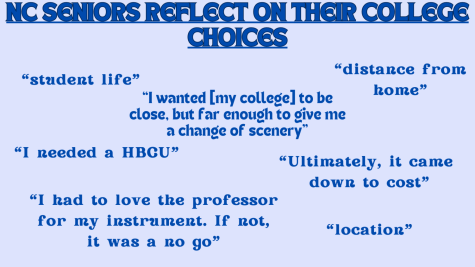Applying and deciding, what to factor?
As May 1 approaches, NC seniors who applied in the early action and regular decision windows will celebrate National Decision Day by publicly announcing their college decisions. During their four years of high school, the seniors worked to receive acceptance letters into their desired colleges. Although, such a choice does not come without hardship. Juniors and seniors must determine which factors take importance when applying to and deciding on their future college.
March 11, 2023
As the class of 2023 purchases their caps and gowns, seniors plan their steps after graduation and juniors begin their list of colleges to apply to and visit this summer. Though seniors and juniors have looked forward to this time for years, deciding where to spend the next four years of their lives can pose a tough challenge. “I applied to a variety [of schools] because I wanted to make sure I had options in case I changed my mind. I applied to those both close and far, a small body of students [and] large [student body],” senior Alina Autry said.
Despite receiving encouragement and guidance from school counselors, friends and family, students may feel overwhelmed with overbearing choices. Though important factors for college applications and decisions vary from person to person, NC seniors determined several factors that impacted their decisions to their colleges this year.
Cost
Despite various state programs such as Georgia’s Helping Outstanding Pupils Educationally (HOPE), the average annual cost of tuition in the United States sums to nearly $35,550—for reference, average median household incomes added to nearly $69,560 in 2019. Due to outrageous costs, NC seniors worked diligently during their high school years to qualify for scholarships and grants such as HOPE and Zell Miller. These programs helped NC students afford excellent colleges in the state such as Kennesaw State University, Georgia Southern, Georgia State University and of course, the infamous University of Georgia.
Although Georgia contains superb universities, students who received scholarships to out-of-state colleges or scholarships that financed any accredited U.S. university received the opportunity to look beyond the state lines.
Location
After 17 to 18 years of living with their guardians, countless students cannot wait to move far away. While expensive out-of-state tuition poses a hardship, scholarships and financial aid assist students who long for a home away from home in their prestigious dream college.
Those who planned to move a great enough distance to develop their sense of individualism, but close enough to visit their loved ones, picked colleges in distant Georgia and in surrounding states such as The University of Alabama, University of Tennessee and Clemson University.
“ I wanted [my college] to be kind of close but far enough to give me a change of scenery. I wanted a school that isn’t exactly a super part school but isn’t boring either. That’s the reason I’m leaning more toward UGA because of how vibrant the student life can be with all the football games and rallies,” Autry said.
Cultural and religious affiliations
One hundred and seven Historically Black Colleges and Universities(HBCUs) exist in the U.S., and NC’s student body applied to these colleges knowing they would receive an academic challenge and a sense of community during their years in undergrad. With various NC students’ accepted into schools such as Spelman University, Morehouse College and Savannah State University, students can remain in-state and live in a stable, nurturing environment.
Similarly, students will attend a college associated with their religious affiliation. With approximately 900 religiously affiliated colleges in the U.S., students from various religions can attend a college that will provide an academic and religious education.








